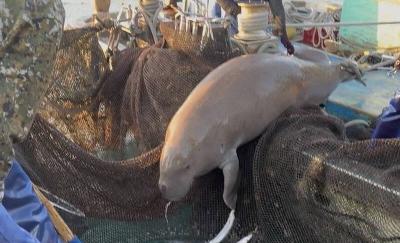More than 150 works of art and relics unearthed in Xinjiang, China, including the mummy “Loulan Beauty,” will be displayed in Taipei to showcase the cultural diversity of the Silk Road, the exhibition’s curators said yesterday.
Titled “Legends of the Silk Road — Treasures from Xinjiang,” the exhibition will give the public an idea of the cultures that converged on the ancient trade route, said Huang Yung-chuan (黃永川), director of the National Museum of History.
Huang said the works of art, well-preserved thanks to the dry climate in western China, have great academic value for the study of trade, transportation and Chinese-Western exchanges on the Silk Road.
They will also allow a glimpse into the diverse customs and traditions of ancient civilizations, such as ancient funeral rites, he said.
The most eye-catching exhibit is the “Loulan Beauty” mummy, which dates back 3,800 years, he said.
The mummy is the remains of an Indo-European female who was between 40 and 45 years of age when she died.
She was unearthed lying on her side as though in sleep, a tuft of hair falling across her head and ragged moccasins on her feet.
The mummy was discovered in the 1980s in the ancient Loulan region along China’s Silk Road in Xinjiang Province.
“Through the current exhibition, we hope the distance between Xinjiang and Taiwan can be narrowed, and that Taiwanese can have a better understanding of Xinjiang and the cultures of the Silk Road,” Huang said.
The exhibition will also include pre-Qin metal vessels, textiles dating back to the Han Dynasty and later, funeral objects found in the Xiaohe Cemetery and paintings on silk from the Tang Dynasty.
The museum divided the 150 items into five categories: the beauty of the Silk Road, the traces of the Silk Road, the wonders of the Silk Road, the ancient kingdoms of the Silk Road and the gods of the Silk Road.
The exhibition will be held from today until March 15 at the National Museum of History.

‘DENIAL DEFENSE’: The US would increase its military presence with uncrewed ships, and submarines, while boosting defense in the Indo-Pacific, a Pete Hegseth memo said The US is reorienting its military strategy to focus primarily on deterring a potential Chinese invasion of Taiwan, a memo signed by US Secretary of Defense Pete Hegseth showed. The memo also called on Taiwan to increase its defense spending. The document, known as the “Interim National Defense Strategic Guidance,” was distributed this month and detailed the national defense plans of US President Donald Trump’s administration, an article in the Washington Post said on Saturday. It outlines how the US can prepare for a potential war with China and defend itself from threats in the “near abroad,” including Greenland and the Panama

A wild live dugong was found in Taiwan for the first time in 88 years, after it was accidentally caught by a fisher’s net on Tuesday in Yilan County’s Fenniaolin (粉鳥林). This is the first sighting of the species in Taiwan since 1937, having already been considered “extinct” in the country and considered as “vulnerable” by the International Union for Conservation of Nature. A fisher surnamed Chen (陳) went to Fenniaolin to collect the fish in his netting, but instead caught a 3m long, 500kg dugong. The fisher released the animal back into the wild, not realizing it was an endangered species at

The Chinese Nationalist Party (KMT) is maintaining close ties with Beijing, the Democratic Progressive Party (DPP) said yesterday, hours after a new round of Chinese military drills in the Taiwan Strait began. Political parties in a democracy have a responsibility to be loyal to the nation and defend its sovereignty, DPP spokesman Justin Wu (吳崢) told a news conference in Taipei. His comments came hours after Beijing announced via Chinese state media that the Chinese People’s Liberation Army’s Eastern Theater Command was holding large-scale drills simulating a multi-pronged attack on Taiwan. Contrary to the KMT’s claims that it is staunchly anti-communist, KMT Deputy

The High Prosecutors’ Office yesterday withdrew an appeal against the acquittal of a former bank manager 22 years after his death, marking Taiwan’s first instance of prosecutors rendering posthumous justice to a wrongfully convicted defendant. Chu Ching-en (諸慶恩) — formerly a manager at the Taipei branch of BNP Paribas — was in 1999 accused by Weng Mao-chung (翁茂鍾), then-president of Chia Her Industrial Co, of forging a request for a fixed deposit of US$10 million by I-Hwa Industrial Co, a subsidiary of Chia Her, which was used as collateral. Chu was ruled not guilty in the first trial, but was found guilty